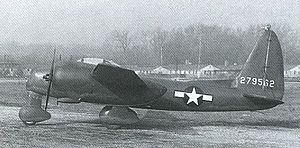| XBQ-2 | |
|---|---|
| Role | Flying bomb |
| National origin | United States |
| Built by | Fleetwings |
| First flight | 1943 |
| Primary user | United States Army Air Forces |
| Number built | 1 |
| Variants | Fleetwings BQ-1 |
The Fleetwings BQ-2 was an early expendable unmanned aerial vehicle — referred to at the time as an "assault drone" — developed by Fleetwings during the Second World War for use by the United States Army Air Forces. Only a single example of the type was built; the aircraft was deemed too expensive for service and was cancelled after a brief flight testing career.
Development[]
Development of the BQ-2 began on July 10, 1942, under a program for the development of "aerial torpedoes" - unmanned flying bombs - that had been instigated in March of that year. Fleetwings was contracted to build a single XBQ-2 assault drone,[1] powered by two Lycoming XO-435 opposed piston engines, and fitted with a fixed landing gear in tricycle configuration;[2] the landing gear was jettisonable for better aerodynamics.[1] The BQ-2 was optionally piloted; a single-seat cockpit was installed for ferry and training flights; a fairing would replace the cockpit canopy on operational missions.[2] The BQ-2 was intended to carry a 2,000 pounds (910 kg) warhead over a range of 1,717 miles (2,763 km) at 225 miles per hour (362 km/h); the aircraft would be destroyed in the act of striking the target.[1] A single BQ-1 was to be constructed as well under the same contract.[1]
Flight testing[]
The XO-435 engines were dropped from the design of the XBQ-2 before completion, being replaced by two Lycoming R-680 radial engines, with the aircraft being redesignated XBQ-2.[3]
Following trials of the television-based command guidance system using a PQ-12 target drone, the XBQ-2A flew in mid 1943; following flight trials, the design was determined to be too expensive for operational use, and the program was cancelled in December of that year.[2]
Specifications (XBQ-2A)[]

The XBQ-2A.
Data from [2]
General characteristics
- Crew: 1 (optional)
- Wingspan: 48 ft 7 in (14.81 m)
- Gross weight: 7,700 lb (3,493 kg)
- Powerplant: 2 × Lycoming R-680-13 radial piston engines, 280 hp (210 kW) each
PerformanceArmament
- 2,000 pounds (910 kg) warhead
See also[]
- Fleetwings BQ-1
- Fairchild BQ-3
- Interstate TDR
References[]
| Wikimedia Commons has media related to Fleetwings. |
- Notes
- Bibliography
- Andrade, John (1979). U.S. Military Aircraft Designations and Serials since 1909. Leicester, UK: Midland Counties Publications. ISBN 0-904597-22-9.
- Parsch, Andreas (2005). "Fleetwings BQ-1/2". Directory of U.S. Military Rockets and Missiles, Appendix 1: Early Missiles and Drones. designation-systems.net. http://www.designation-systems.net/dusrm/app1/bq-1.html. Retrieved 2013-01-22.
- Werrell, Kenneth P. (1985). The Evolution of the Cruise Missile. Maxwell AFB, Alabama: Air University Press. ISBN 978-1478363057.
| |||||||||||||||||
The original article can be found at Fleetwings BQ-2 and the edit history here.
